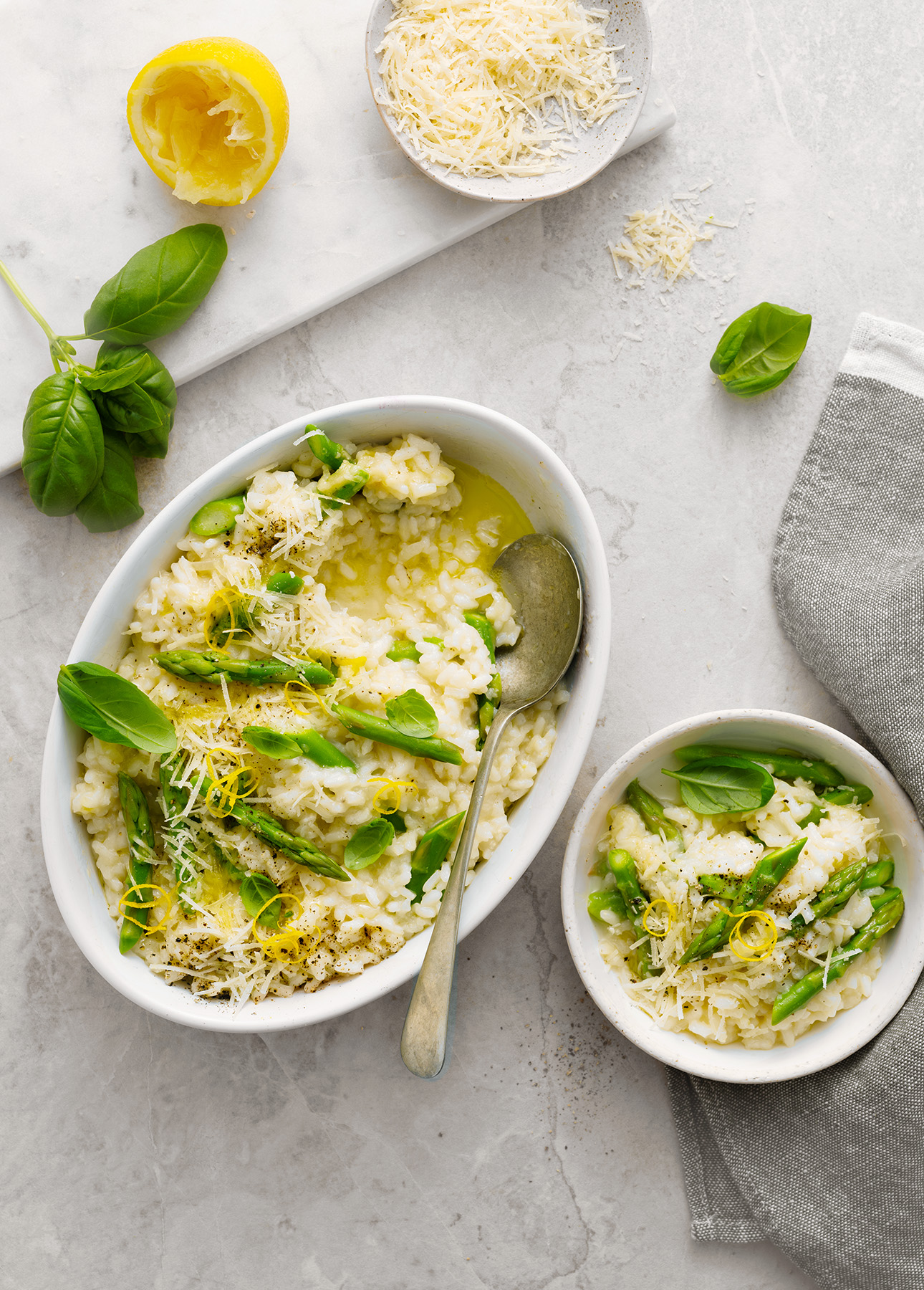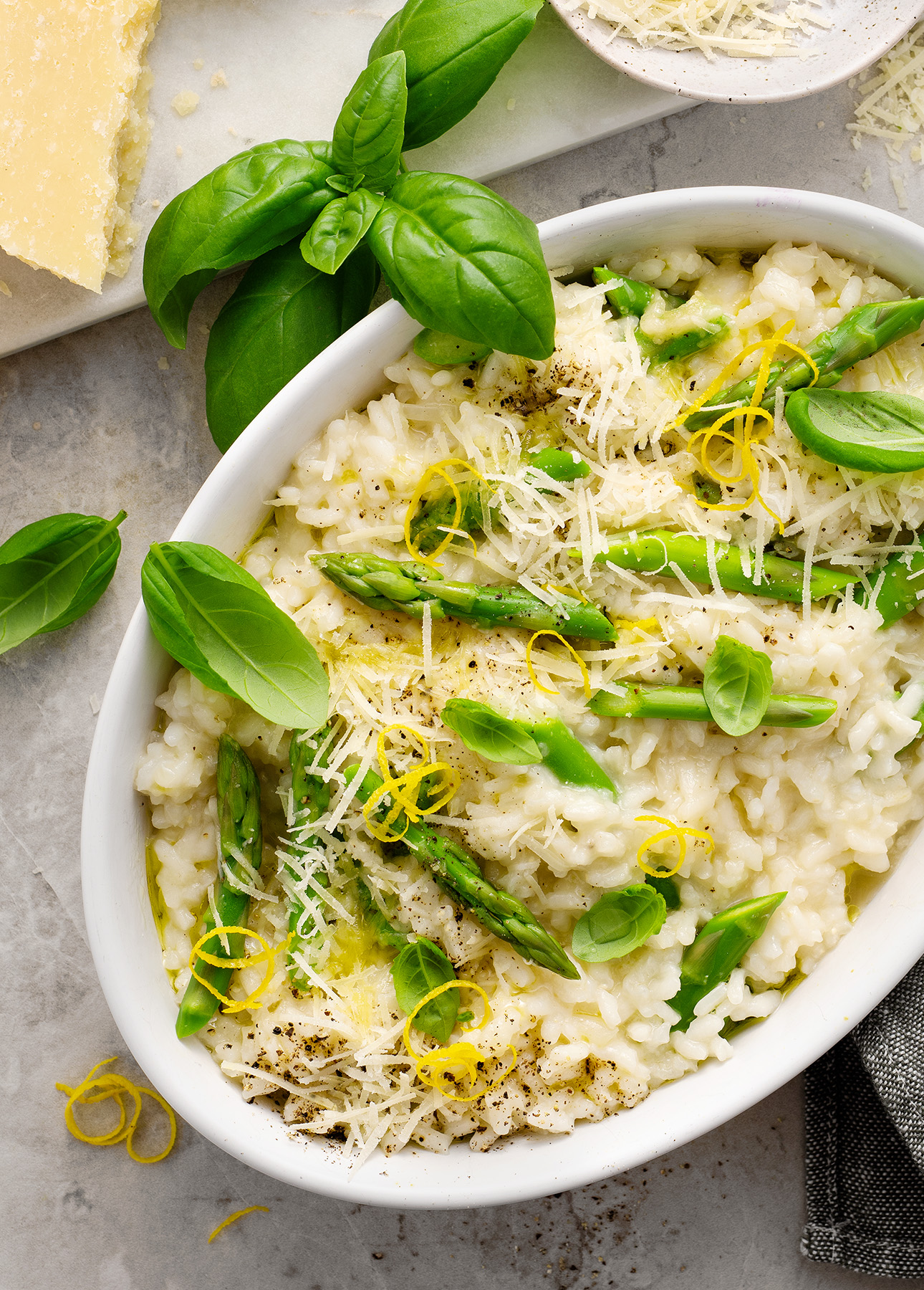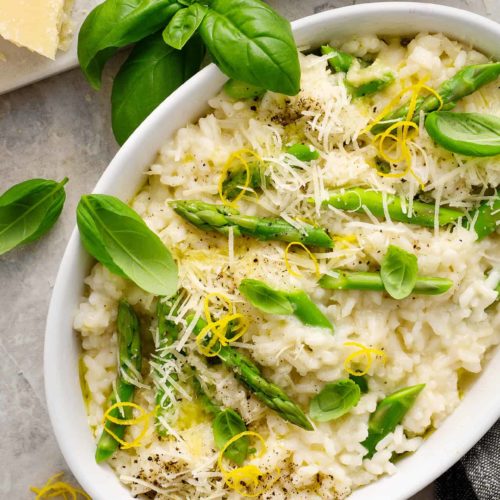This creamy asparagus risotto combines zesty lemon with the iconic, bright green spring stalks. A delightful dish for special nights, but quick enough for weeknights, too!

What’s your favorite dish to make with asparagus? I’m a huge fan of the spring stalk. I use it in and over a variety of dishes, from pizza, to pasta, to stir-fries, to delightful breakfast dishes.
Asparagus are especially delicious in cheesy, creamy settings, which is why lemon asparagus risotto is invariably one of the first dishes I make with the initial bundle of asparagus I get my hands on every spring.
Risotto is quick and easy enough to make on a weeknight—and this lemon asparagus risotto is especially so because it doesn’t require any advance prep. You simply get the risotto started, and while the rice cooks, you wash and chop the asparagus. A few minutes before the end of the cooking time, you throw in the asparagus, lemon zest, and juice, and voilà! About 30 minutes after you got started, you’ve got a luxurious dish to dig into.
Although lemon asparagus risotto is totally doable on a weeknight, you should, of course, totally make it on weekends, too! Who said cooking for special nights should require you to slave over the stove for hours? This elegant dish will make you feel like a chef and leave you relaxed and ready to enjoy it, too.

Helpful Tips for Making Lemon Asparagus Risotto
- Great news! You don’t need to blanch fresh spring asparagus before using them: Many recipes require you to blanch asparagus before using them—that is, plunge them into boiling water for a few seconds, then transfer them to ice water to stop the cooking process. This is a fussy process, and I’ve honestly never encountered a recipe in which blanching the asparagus was a real requirement, except in salads where the asparagus are used as is (and even then, I prefer thinly slicing the asparagus and using them raw instead of blanching them). Fresh spring asparagus are sweet and crunchy, and they’re ready to use as is in any dish. The heat from the cooking process will allow them to get to their crisp-tender stage without the need for any advance blanching.
- Asparagus require very little time to get to that crisp-tender stage: Asparagus is at its very best when it’s cooked for a very short amount of time. Not only does a short cooking time allow the stalks to retain their bright green color, but it also keeps them crunchy, instead of turning them to a mushy, fibrous mess.Fresh spring asparagus have stalks that average 1/2 inch (1 cm) in diameter at the base. For this risotto, I like to cut them into 2-inch (5 cm) lengths. The recipe instructs you to add the asparagus almost at the very end of the cooking process. This might sound surprising, but it’s actually just what the asparagus needs. Plus, the stalks will keep cooking in the residual heat while you serve and enjoy the risotto. So make sure not to add the asparagus too early!Adjust the recipe according to the asparagus you have on hand: If your asparagus stalks are thicker than 1/2 inch (1 cm) in diameter at the base, slice them into shorter lengths. If they’re thinner, only add them about a minute or two before serving.
- For the very best risotto flavor, seek out authentic Parmigiano-Reggiano cheese: Parmigiano-Reggiano has a sharp, nutty, salty flavor that lends a ton of flavor and an unforgettable creaminess to risotto. No need to add extra butter or cream to your risotto when you use the real stuff! Authentic Parmigiano-Reggiano is controlled under a Denominazione d’Origine Protetta (protected designation of origin), which means it has to be produced a specific way in specific regions of Italy to be awarded the name. Authentic Parmigiano-Reggiano has a stamped rind, is aged at least 12 months, and is usually labeled with its original Italian name (as opposed to just “parmesan.”) Yes, Parmigiano-Reggiano is more expensive than cheese products labeled parmesan, but you don’t need a lot to make your dishes extra special. Save it for recipes that make the most of its unique flavor, such as this lemon asparagus risotto!
- Add garnishes to give your risotto a chef’s touch: This lemon asparagus risotto is gorgeous and ready-to-eat as soon as it’s finished cooking. But you can take an extra minute to top each serving with fresh ingredients such as fresh basil leaves, curly lemon zest, and a drizzle of extra-virgin olive oil to push it to chef’s levels, both in terms of looks and textures.
- Easily scale up the recipe to serve the number of guests you’re treating: Most risotto recipes serve 4 to 6, with ingredient quantities that are hard to split into halves or thirds. This has always annoyed me because I usually make risotto for 2 people. So I’m writing all my risotto recipes to serve 2, which means the math is easier to scale up the ingredients to serve 4 or 6 guests.Note that this lemon asparagus risotto recipe produces a generous 2-serving yield—you could stretch it to 3 servings if this dish is part of a more elaborate menu that includes appetizers and sides.


Lemon Asparagus Risotto
Ingredients
For the risotto
- ½ lb fresh asparagus shoots
- 3 cups low-sodium chicken broth, or vegetable broth
- 2 tbsp butter
- 2 tbsp extra-virgin olive oil
- 1 shallot, minced, or substitute ¼ cup (60 ml) minced onion
- 5 oz risotto rice (Arborio, Carnaroli, or Vialone Nano)
- ½ cup dry white wine, such as Pinot Grigio
- 2 oz finely grated Parmigiano-Reggiano cheese
- Finely grated zest and juice from ½ lemon (about 1 tbsp/15 ml zest and 2 tbsp/30 ml juice)
To serve (optional, to taste)
- Fresh basil leaves
- Lemon zest
- Extra-virgin olive oil
- Freshly ground black pepper
Instructions
- Snap off the tougher ends of the asparagus and discard. Slice the stalks cut into 2-inch (5 cm) lengths and set aside.
- To prepare the risotto: Pour the broth in a medium saucepan. Bring to a slow simmer, then lower the heat, cover and gently simmer for 5 minutes. Lower the heat to the minimum, then keep warm.
- In a large saute pan or a cast-iron braiser set over medium-low heat, melt the butter in the olive oil. Add the shallot and cook, stirring, until soft, 3 to 4 minutes. Add the risotto rice and stir for 2 minutes, until the grains are translucent around the edges. Add the wine and stir vigorously while the wine is bubbling up, scraping down the bottom of the pan to loosen the caramelized bits. Simmer until the wine is fully absorbed. Add 1 ladleful of the broth and simmer, stirring from time to time, until the broth is almost completely absorbed. Continue adding broth, one ladleful at a time, allowing each ladle to be absorbed before adding more.
- When there's about 1 cup of broth left, add the asparagus stalks to the risotto and stir to incorporate. Add ½ cup (125 ml) broth, stir and keep cooking until the broth is almost fully absorbed. Stir in the grated Parmigiano-Reggiano cheese. Stir until the cheese is fully melted and incorporated. Stir in the lemon zest and juice. Taste the risotto and adjust the seasoning if needed. Stir in the remaining broth. The risotto should now be loose and super creamy. Cover and turn off the heat. The risotto can stand for about 5 minutes but should be served as soon as possible for the best texture.
- SERVING: Serve the risotto in warm bowls, then garnish each serving with fresh basil leaves, lemon zest, a drizzle of flavorful extra-virgin olive oil, and some freshly ground black pepper. Serve immediately.
- STORAGE: This lemon asparagus risotto is best enjoyed within minutes of being made. If you do have leftovers, refrigerate in an airtight container for up to 2 days. To reheat, transfer to a nonstick skillet, add a couple tablespoonfuls of broth or water and warm up over medium-low until the risotto is loose and hot. Serve immediately.
- MAKE IT VEGETARIAN: Make sure to use vegetable broth.
The post Lemon Asparagus Risotto appeared first on Food Nouveau.

Leave a comment